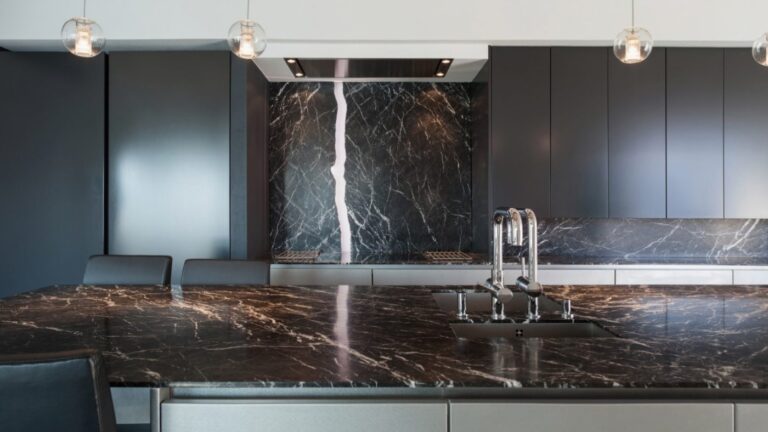Marble and Granite counters are some of the best material to use when updating a space in your home. Marble and Granite add elegance and refinement and their aesthetics are rich and luxurious. Whether you’re deciding between installing granite or marble in your bathroom or kitchen, it’s beneficial to weigh the pros and cons and see the difference between the two. How to decide between marble or granite counters is a process that should be well thought-out and researched. Whether it’s deciding on price, look, or cleaning requirements, the following information will help you make an informed decision.
The Similarities
Let’s start with the similarities between marble and granite. Both are natural stones so naturally they are more expensive than most other countertop materials. They are also both highly desired among homeowners because of their sophisticated look. Granite and marble are also both highly durable. They are harder stones so wear and tear isn’t as much of an issue as it can sometimes be with other materials. Lastly, marble and granite are also heat resistant. That being said, it’s important to be careful and not recklessly and consistently place extremely high heat pots and pans on the surface. Always use caution and place a towel or mat underneath any hot items that may come in contact with a marble or granite surface.
Price and Value
Although the price of marble and granite are similar, marble is more expensive than granite. Marble is more highly desired by homeowners over granite because of its pristine and uniform look, but it means you’ll be spending more money. To save on marble, you can buy it in tile form rather than in large slabs. This won’t save you an enormous amount of money but it will help you have some leftover finances for any finishing touches.
Usually granite starts selling around $70-75 per square foot, and marble begins at about $100 per square foot. Clearly, the difference is only about $25 between the two per square foot, but in the long run purchasing granite will save you more money. Many homeowners still opt to buy marble because it can increase a home value at the time of resale.
Appearance and Presentation
While both marble and granite are excellent choices as countertop materials, they have their distinct differences when it comes to their appearance and presentation.
Granite is identifiable by its grainy and speckled look. The hues of these grains and speckles are usually medium to dark in shade. The look and patterns of granite can also vary greatly all over a slab, although it still has an overall uniform look when it’s all put together. Granite has a large selection of colors and patterns to choose from and every slab is unique in its design.
Marble also comes in different colors and patterns but it’s most commonly purchased in its classic white color with grey veining throughout. Marble differs from granite in that it does not contain hardly any grain or speckling. Instead, it has larger patterns of veins that run throughout the slab. Although it’s widely purchased in its classic white and grey veined combination, it’s also available in brown, beige, and light yellow colors.
In terms of presentation, the biggest factor in your decision will be countertop thickness. While most agree that the thicker width of the marble or granite is best, a smaller thickness can still get the job done. The countertop thickness is usually determined by the room that the slabs will be used in. In the kitchen for both marble and granite, the standard thickness is 3cm. When using granite or marble counters in the kitchen, the thickness will be, and should be greater because of the extensive use of kitchen counters and islands. For bathroom counters and vanities, the thickness is around 2cm. You can go even thinner, but the look isn’t as grand, and the natural stone is more vulnerable to wear and tear. Most want to have a thicker countertop because it looks much more luxurious and it makes your counters stand out. Before deciding on thickness, remember that marble is more expensive so the more thickness you add, the more money you will be paying. Granite will also cost more if you decide to increase thickness. You can save a few dollars by adhering to a standard thickness on your counters and add a touch of thickness to a small kitchen island, or bathroom vanity top.
Countertop Maintenance
Granite is an igneous rock, and to put it simply is a harder natural stone than marble. Granite is more resistant to wear like scratches, chips, and etching. Granite is a porous stone, meaning liquids can eventually seep through the stone and leave a stain if it’s not properly maintained.
Granite is more easily maintained than marble, and is recommended for use in kitchens because of its hardness and greater durability.
Although marble is also highly durable, it is more high maintenance in terms of taking care of your counters. Marble is a metamorphic rock which means that it is softer than granite. Similar to granite, it is also a porous surface that can easily stain, and stains more quickly than granite. Never store acidic food on a marble countertop because it will ruin the marbling effect. If you ever have any spills on a marble surface, use a soft towel to clean up right away. Never leave any spills on the surface of marble longer than a couple minutes. Because of its tendency to require more care, marble is not always recommended for use in the kitchen. Its use is far more suited for a bathroom countertop or vanity. That being said, with proper upkeep, it will look absolutely marvelous in your kitchen and serve its purpose.
As with all counters, especially ones made of marble or granite, special care and upkeep should always be taken in order to preserve the appearance and effectiveness of the stone. Granite and marble counters should be sealed once every one to two years because of their porous surface. Also, take careful measures not to clean your marble or granite countertop with harsh chemicals. Using harsh chemicals will strip the sealant and will remove protection against spills, stains, and scratches.
Your Choice
Deciding between marble or granite counters is a decision that requires taking several factors into account. Price, look, and maintenance are all important variables in selecting the right choice for your home. At the end of the day, make sure you’re happy with the result, even if it means spending more or less, or having to maintain one more often over the other.




Comments are closed.